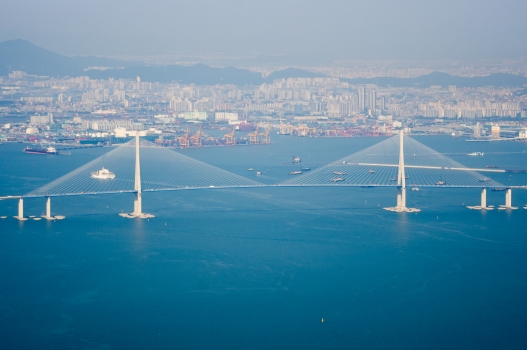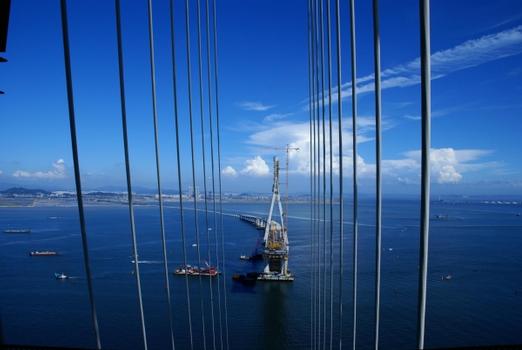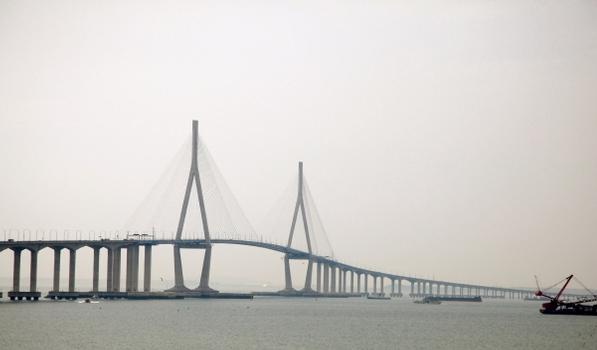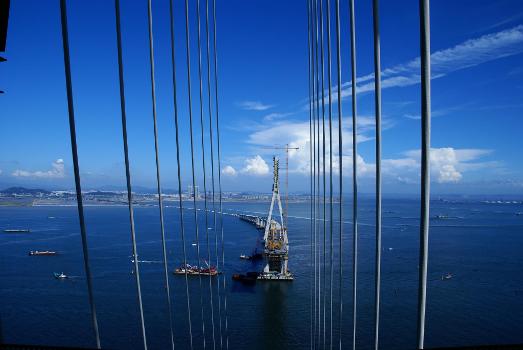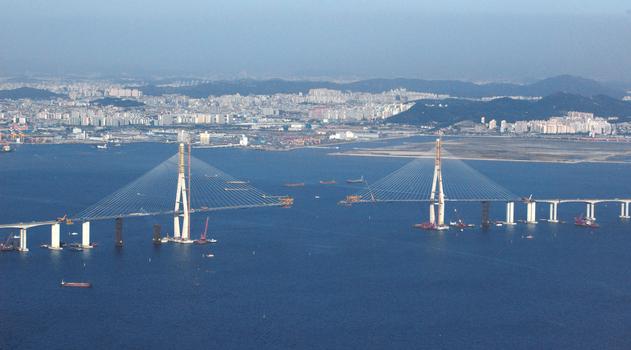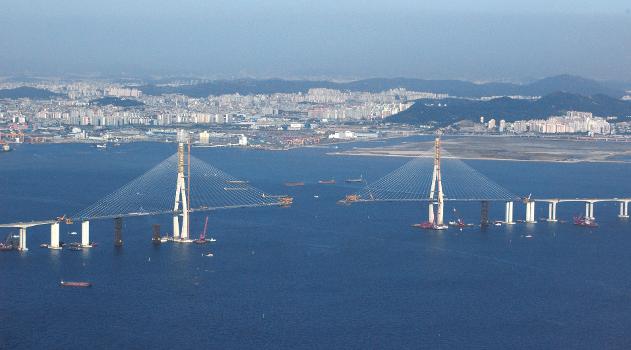General Information
| Name in local language: | 인천대교 (Incheon-daegyo) |
|---|---|
| Other name(s): | Incheon Grand Bridge |
| Beginning of works: | 2005 |
| Completion: | 26 October 2009 |
| Status: | in use |
Project Type
| Structure: |
Cable-stayed bridge with semi-fan system |
|---|---|
| Function / usage: |
Motorway bridge / freeway bridge |
| Support conditions: |
for registered users |
| Material: |
main bridge: Steel bridge Structurae Plus/Pro - Subscribe Now! approach viaducts: Prestressed concrete bridge |
| Structure: |
approach viaduct: Box girder bridge |
| Secondary structure(s): |
Structurae Plus/Pro - Subscribe Now! |
| Material: |
Structurae Plus/Pro - Subscribe Now! |
| Construction method: |
deck of approach viaduct: Precast segmental construction |
| Secondary structure(s): |
Structurae Plus/Pro - Subscribe Now! |
Awards and Distinctions
| 2011 |
Award of Merit
for registered users |
|---|
Location
| Location: |
Incheon, South Korea |
|---|---|
| Coordinates: | 37° 24' 50.76" N 126° 33' 59" E |
| Coordinates: | 37° 24' 22.77" N 126° 36' 36.21" E |
| Coordinates: | 37° 28' 17.41" N 126° 30' 41.42" E |
Technical Information
Dimensions
| total length | 21.38 km | |
| main bridge | ||
|---|---|---|
| main span | 800 m | |
| total length | 1 480 m | |
| span lengths | 80 m - 260 m - 800 m - 260 m - 80 m | |
| number of spans | 5 | |
| pylons | height | 238.5 m |
Materials
| piers |
reinforced concrete
|
|---|---|
| pylons |
reinforced concrete
|
| deck of main bridge |
steel
|
| deck of approach viaduct |
precast prestressed concrete
|
Case Studies and Applied Products
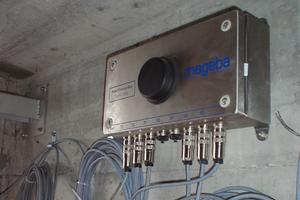
ROBO®CONTROL Permanent – Remote Monitoring System
Robo®Control detects the absence of machine specifications at the component and conveys these to a central computer. There the data are processed and they are made available to the clients through internet.
[more]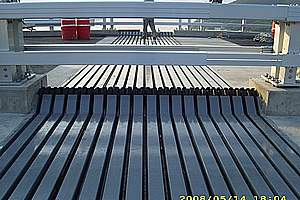
TENSA®MODULAR LR & LR-LS – Modular expansion joints
Modular Expansion Joints can be constructed for any movements, from about 100 mm up to 2,000 mm and more. They allow movements in all 3 directions and rotations around all 3 axes.
[more]Excerpt from Wikipedia
The Incheon Bridge (Korean: 인천대교; RR: Incheon-daegyo) is a reinforced concrete bridge in South Korea. At its opening in October 2009, it became the second connection between Yeongjong Island and the mainland of Incheon. The Incheon Bridge is South Korea's longest spanning cable-stayed bridge. In comparison, it is the world's tenth longest cable-stayed bridge as of January 2019. The bridge provides direct access between Songdo and Incheon International Airport, reducing travel time between them by up to one hour.
The section of the bridge crossing the sea, whose concessionaire is Incheon Bridge Corporation, is funded by the private sector. Korea Expressway Corporation and the Korean Ministry of Land, Transport and Maritime Affairs (MLTM) managed the project.
Construction
The main design and build contractor was Samsung C&T Corporation JV (Daelim, Daewoo, GS, Hanjin, Hanwha, Kumho). Total costs were ₩2.45 trillion, including federally funded approach roads. The 21.38-kilometre-long (13.3 mi) highway project consisted of government-built sections at three ends and a 12.34 kilometres (7.7 mi) section in the middle built with private capital. The bridge section is 18,384 metres (60,315 ft) long. The bridge has a cable stayed section over the main sea route to Incheon port. This was the most difficult part to construct, with a main tower 230.5 metres (756.2 ft) high, vertical clearance of 74 m (243 ft), and five spans: a centre span of 800 m (2,625 ft) flanked on either side by spans of 260 m (853 ft) and 80 m (262 ft). Adjacent to the center section are approach spans consisting of a series of 150 m (492 ft) balanced cantilever spans. Lower-level viaducts consisting of 50 m (164 ft) spans connect to land at each end of the bridge.
Design
Because the bridge is situated in a known seismically-active region, a seismic design of the substructure was adopted.
At 12.3 km long, with a main cable stayed span of 800m, the new Incheon Bridge is one of the five longest of its type in the world. Its 33.4m wide steel/concrete composite deck carries six lanes of traffic 74 m above the main shipping route in and out of Incheon port and links Incheon International Airport on Yeongjong Island to the international business district of New Songdo City and the metropolitan districts of South Korea's capital, Seoul. The cable stayed section of the crossing is 1,480 m long, made up of five spans measuring 80 m, 260 m, 800 m, 260 m and 80 m respectively: height of the inverted Y main towers is 230.5 m. A 1.8 km approach span and 8.7 km viaduct complete the crossing, both constructed with precast prestressed concrete box girder decks. Foundations are drilled piles 3 m in diameter. In order to accommodate movement between the bridge decks, the Incheondaegyo was equipped with expansion joints weighing up to 50 tons per joint.
Text imported from Wikipedia article "Incheon Bridge" and modified on July 23, 2019 according to the CC-BY-SA 4.0 International license.
Participants
Relevant Web Sites
Relevant Publications
- Building on firm ground. In: Bridge Design & Engineering, v. 11, n. 38 (1st Quarter 2005), pp. 48-49.
- (2006): Business booster. In: Bridge Design & Engineering, v. 12, n. 43 (2nd Quarter 2006), pp. 30-31.
- (2009): Design and Construction of Pre-tensioned Prestressed Concrete Box-Girders in Incheon Bridge Viaduct. Presented at: IABSE Symposium: Sustainable Infrastructure - Environment Friendly, Safe and Resource Efficient, Bangkok, Thailand, 9-11 September 2009, pp. 168-177.
- DYWIDAG Post-Tensioning System incorporated into Korea's largest bridge construction project. Incheon Bridge, Seoul, South Korea. In: DSI Info, n. 15 ( 2007- 2008), pp. 10.
- Giving an Incheon. In: Bridge Update, n. 54 (September 2005), pp. 2.
- About this
data sheet - Structure-ID
20015446 - Published on:
07/03/2005 - Last updated on:
19/02/2023

